Dryland Hopi Corn 2025
Our long term plan is to add inorganic fertilizer and plant a perennial legume crop which can then be harvested as a nutrient rich organic fertilizer/mulch and used for animal feed. Animal waste can then be recycled back to other crops and the legume field. In Sep 2024 we spread 1500lbs of fertilizer on 5 acres and tilled in 3 acres in preparation for alfafa seeding before it was apparent that rain was not coming anytime soon. With no rain we were concerned that a larger area of exposed dry ground would increase the chances of damage by wind erosion, and stopped tilling. Fortunately the soil was uneven with residual stubble and the wind was not strong enough to cause any noticable damage. It did not rain till Nov 1st which was too late to plant alfalfa. Since fertilizer has already been applied to this area and the soil has minimal cover, we will plant this area with corn without retilling in spring of May 2025. There will be some competition with annual spring grass but not tilling will reduce inputs and conserve soil moisture.
In 2024, the Hopi Blue Corn North Field (1.5 acres) was planted too densely and due to lack of moisuture fertilizer wasn't fully utilized, low yield = low fertilizer consumption. We will plant this area in spring 2025 without retilling to conserve soil moisture and make use of previous years fertilizer.
We will till and apply fertilizer as in 2024 with a drill/augur various experimental spacings to optimize planting arrangement and plant density.
Dryland Corn Production Experiment Target
Irrigated high density hybrid dent corn is often planted at about 30,000 plants per acre, or 1.5 sq. ft. per plant, 24 - 30 inch rows, and can yield more than 150 bu./acre with a record of over 600 bu./acre. Another idea is to try to produce as much corn by weight as wheat in the same region. In areas where annual rainfall is less than 12 inches yield is between 27-65 bushels/acre with an average of 48 bushels/acre. We have designed a calculator to help consider various planting arrangements that will meet this target. The calculator can be used for conventional and hill planting arrangements where using 1 plant per hill is the same as conventional row planting. Please see the tip button as it has additional information on how to use the calculator.
Try Our New 2025 Corn Spacing & Yield Calculator
Pueblo Corn Strains For Planting in 2025
We had many color variations of each variety and there are too many to plant them all. The Kikam Hu:n was starchy and we won't be planting this in 2025. Most seeds were saved on the cob and cobs from special color variations and highly producing plants (4, 6, up to 8 ears) were separated and labeled (examples Hopi White Super 4, Hopi Pink Super 6, or Concha White Super 8). Color is not a good indication of variety. Special colors can be easily identifed at planting but ears from highly producing plants need to be separated and labeled. Hopi Blue was planted last in 2024 so we'll plant it first in 2025.
Hopi Corn Strains List 2024
- Concha White (mixed with select Hopi White and Hopi Pink)
- Hopi Pink
- Hopi Blue
- Hopi White
- Kikam Hu:n (Pima 60 Day Corn)
- Smoik Hu:n (Tohono O'odham 60 Day Corn)
- VCOO Pink (Purchased as Hopi Pink but looks like Wikti)
- Wikti
Hopi Corn Varieties & Labeling
We separated all varieties based on color and color pattern except the VCOO pink where we only classified (VCOO Pink Super 6, VCOO Pink, and VCOO Pink reject). The VCOO Pink Super 6 was notable as it had several ears at the tips of stalks and produced 1.33 lbs of corn on a single plant. Kikam Hu:n was separarted as flinty and less flinty.
In 2024 we planted new Hopi White corn (first 4 rows) and our 2024 Hopi White in adjacent plots. The first 4 rows were mostly white with some pink and dark pink variations with few (cross pollinated) blue kernels while the other rows had a few plants with 50:50 white/blue ears (Hopi Blue crosses from 2023). These were segregated as Hopi White first 4 rows and just "Hopi White". Super producers were labeled Super (#ears per plant). Below is an example of how we have separated and labeled varieties for breeding. Origin strain first followed by other information such as color, productivity, source, texture, or quality. Below is an example of color and trait sorting for the Hopi White, and other strains were similarly sorted.
|
|
|
"Glow" were pink colored or darker colored around the sides with lighter white or yellow crowns. Blue glow had light blue crowns. Pink-A-Dot were mostly white with a pink dot. Hopi Pink also had the glow and stripe color patterns. One Hopi Blue ear had a few green or yellowish crown kernels that we called green eye. The Hopi White grape had very large kernels and is presumably Hopi White - dark pink crossed with Hopi Blue. They look somewhat like small grapes. We weighed the kernels and good portion were larger than 0.40 grams and a few were as heavy as 0.48 grams.
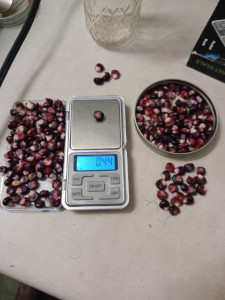

Hopi White Corn - Grape Feb / 2025
|
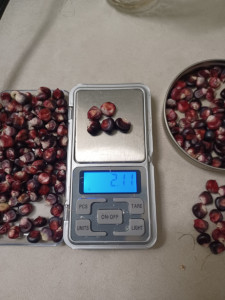
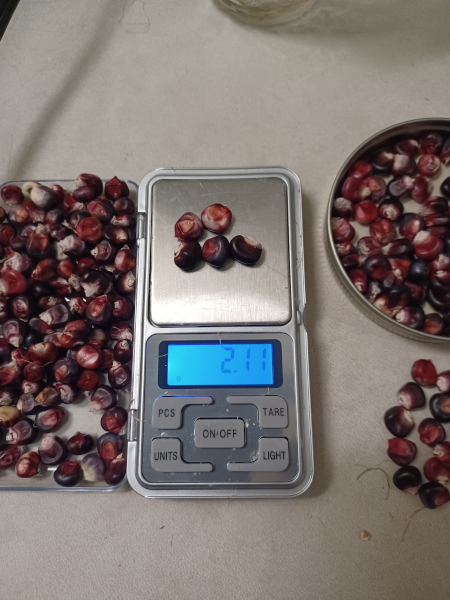
Hopi White Corn - Grape (avg 0.42 grams)
|
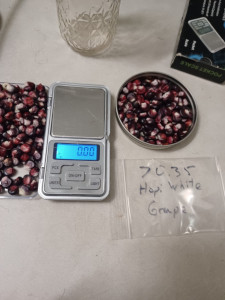
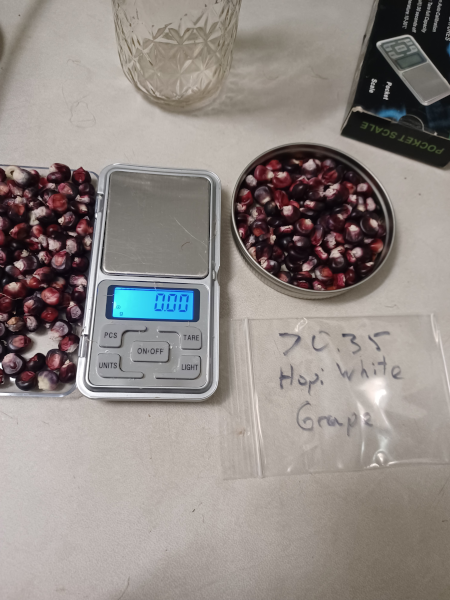
Hopi White Corn - Grape (left < 0.35g ≤ right)
|
Hopi Corn Selected Big Kernels
As of Jan 20 2025 all types of corn had been shelled except the Hopi Blue. Kernels from high yield plants were frequently significantly larger than kernels from other plants of the same variety. There were also some Hopi x Hopi hybrids, and frequently these produced better and had larger kernels than pure Hopi varieties. It seems obvious now that selecting for plants that do well when planted deeply would select for larger kernels. Larger kernels have more energy reserves increasing the chance that when planted deeply they will successfully emerge from the soil. These plants develop faster enabling them to start absorbing light earlier and grow deep roots accessing ground moisture before the full onslaught of summer heat. We sorted the Hopi Blue and selected 25 to 30 ears with larger than average kernels and will use these to breed corn with larger kernels. We'll also sort through the Hopi Pink, Hopi White, and Hopi x Hopi hybrids to select larger kernels for the same purpose.
I sorted some Hopi Blue Corn ears that appeared to have larger kernels and then weighed and selected the biggest to try and breed for larger kernels and to compare with average field corn weights. I considered any that were over 0.36 as noticably larger than my average, and separated those heavier than 0.35g for selective breeding. Of these selected kernels about 30% were heavier than 0.40 grams and one that was a whopping 0.49 grams.
| How Many Corn Kernels Per Pound | ||
|---|---|---|
| Description | Weight in grams | Kernels per Pound |
| Popcorn | 0.125 | 3629 |
| Sweet Corn | 0.227 | 2000 |
| Wikti & Smoik Hu:n | 20g - 25g | 1814 - 2268 |
| Hopi 2023 Average | ~0.291 | 1500 - 1560 |
| Field Corn | 0.349 | 1300 |
| Smallest Selected Hopi Blue | 0.35 | 1296 |
| Peruvian Purple | 0.38 | 1193 |
| Very Large Selected Hopi Blue | 0.40 | 1134 |
| The Largest Selected Hopi Blue | 0.49 | 926 |
| Peruvian Choclo (10 months to maturity) | 0.95 | 478 |
| Giant Cuzco | 1.34 | 338 |
Effects of Reduced Plant Density on Unirrigated Dryland Hopi Corn
- Less competition for water, light, and nutrients,
- Quality and yield are increased per material inputs (fertilizer, fuel, etc).
- Labor input may be decreased per yield output.
Negative Effects of Reduced Plant Density and Other Considerations
- More land area is used per yield output.
- Increased total labor per area cultivated (walking between plants for maintenance and harvest).
- Increased chance of soil erosion depending on planting arrangement.
- Increased chance of lodging and damage by wind depending on planting arrangement.
- Cross pollination reduced and not as efficient depending on planting arrangement.
- Decreased humidity and increased evaporation depending on planting arrangement.
- Less shading and increased temperatures depending on planting arrangement.
Planting in hills will mitigate some of the negative effects of decreased plant density.
To minimize competition and get the most plants per area, plant corn individually equidistant such that plants in each row are midway between plants of adjacent rows. Studies have shown that multiple permeable barriers perpendicular to prevailing winds reduce wind and erosion caused by wind more than impermeable barriers. Wind goes over and wind speed is reduced only very near impermeable barriers. This indicates that even spacing or evenly spaced hill planting may better mitigate the negative effects of wind on crops and soil. A barrier only reduces wind speeds in the area downwind that is within 3 times the height of the barrier. If rows or hills are spaced 9' apart the distance between rows will be more than 3x the plant height until plants reach 3 feet in height. While increasing inter-plant competition within a hill, hill planting has the advantages of decreasing labor inputs per plant, increasing the efficiency of pollination, reducing damage by wind and pests, and reducing evaporation by creating a microclimate. As we still do not know optimal plant density or how hill planting actually affects yield 3 experiments intially come to mind.
- Determinte optimal density, plant corn individually 3' x 3' to 6' x 6' apart.
- Determine optimal plants per hill with a 9' x 9' hill spacing (2 - 7 plants per hill).
- Determine optimal hill spacing (too many variations to test in one year).
The initial value ranges are based on traditional native planting practices with hills spaced 12' x 12' apart with 4 - 7 plants per hill resuling in a density of 20 - 36 sq. ft. per plant. It is likely the optimal number of plants per hill depends on hill spacing. It would also be good to test the optimal plants per hill with various spacing between hills (9' and 20'). In the Collins journal article hills per spaced 20' apart with more plants per hill, so this could be the direction for future experiments. We'll try to test single planting and plants per hill first and use these results to infer a starting point for optimal hlll spacing in future experiments.
Previously I brought up the idea of a genetic component to corn plants that don't produce ears, selfish plants, and later discounted the idea and removed the paragraph. These plants would provide pollen to nearby ear producing plants there by carrying on the trait. Many species of trees produce only male or female flowers which increases genetic diversity but this trait, if it exists in corn, would reduce yield. Earless corn may be the result of a combination of both environmental and genetic factors. Breeding populations should be selected from corn stalks where all nearby stalks also produce ears to select against possible genetic components resulting in "earless stalks".
We took some measurements of part of the 2024 Hopi White field and the rows of interest were 52 inches apart with plants in a zig-zag pattern roughly 1 foot apart. Every 3rd plant usually had an ear indicating that 13 sq. ft. per plant should be enough to produce. Without the 2 earless stalks in every 3 feet of row, the producive plants will do better possibly with less than 13 sq. ft. per plant.
2025 Dryland Hopi Corn Experiments
To increase production / labor and materials input plant spacing needs to be optimized.
We usually plant Hopi Blue last and it seems like Hopi Blue takes longer to mature than other varieties but I am not yet sure it actually takes longer to mature. This year we are planting it first to make sure we get a harvest that dries down well in the field to preserve improve this variety. Improvements in in cultivation methods (decreased planting density) may improve yield and result in earlier dry down (in the field).
Some of the blue from last year has larger kernels and some had huge ears so we'll be trying to improve those, and will plant one area with special colors (yellow and green variants). We'll also designate one area to cross Hopi White - Grape (large blue/white Hopi cross) with the Hopi Blue large kernels. The idea is to create a Hopi corn hybrid with large kernels that may hasten root establishment before spring ground moisture either evaporates or infiltrates deeper into the ground. If at any point we run out of true-to-type Hopi Blue, we have Grade A+ Hopi Blue from previous years saved in the refigerator.
We decided to take the minimum order of fertilizer and reduced the fertilizer application rate for an expected yield of 50 bushels / acre. This was enough fertilizer for 4 acres so we expanded 4 of the fields to a total 3.48 acres.
We did not not plant the north field and left it to provide a protective band and mitigate the effect of wind on tilled areas. Fields are roughly organized so tilled and untilled areas alternate in a north south direction with predominate winds being from the north and south.
This year we have decided to try a few different planting arrangements, measured in paces, to get a rough idea of what works best and leave more precise experiments for next year. It will take a long time to cover the 3.48 acres even without trying to do precise experiements. The goal is to maximize yield and minimize inputs not to optimize yield per acre (at least not yet).
We found a local group interested in homesteading and a couple with tribal affilation interested in learning how to grow Hopi Corn without irrigation generously agreed to help us plant in exchange for part of the produce.
Daily Corn Planting Plan
- April 21 2025. We started the bottom of the blue field with single planting one pace apart and switch to hill planting as we move up the hill. This will be about 9 sq. ft. per plant initially. In 2023 Field 1 was planted with about 3.8 sq. ft. per plant and this was clearly not enough space but if we aim for 42 bushels per acre, 8 sq. ft. per plant is the lowest density we should try. Using the calculator and putting 1 plant per hill with 36 inches plant and 36 inches row distances with a yield 0.45 lbs per plant yields 38 bushels. We'll also do part of this field with 12 sq. ft. per plant in hills. By the end of the day tomorrow we should have an idea of how much we can get done in an evening and adjust the next days planting accordingly.
- We soaked the seeds for 12-36 hours before planting. Seeds can die from a lack of oxygen if soaked too long so if more ttan 12 hours had passed we drained the water and rested the seeds in moist container and alternately soaked them again when dry. One person used a corded drill with 1.5" to 2" auger to drill 5-9 inches deep and another person followed behind and put seed(s) in the hole with a planting tube, 3/4 inch pvc pipe with a bell end. On the second day we realized it is best to cut the planting tube shorter and at a flattened angle on the bottom, and to check the planting tube for soil to help avoid clogging the tube with soil. Also it helps to have a 3rd person place a measured stick ahead of the planters as a guide to get rows more evenly spaced. Once a section is finished we cover the holes completely with loose soil using a rake or hoe.
- Day 1 - About a cup of seeds were soaked. We divided the lower south slope field (17000 square feet) into 3 parts and planted most of the west most 1/3 with large Hopi Blue kernels and a patch of Hopi Blue - yellow and Hopi Blue - green eye. We were using a planting tube which got clogged about half way through so decided to replant the area on another day.
- Day 2 - We cut the planting tube shorter and at an angle, then cut off the sharp tip of the angle, and the tube was checked regularly to make sure it didnt' get clogged with soil. We planted the west most side with large Hopi Blue with a 3-4 rows of extra large Hopi White - grape in the middle. We planted 2 paces by 2 paces with 3 seeds per hole (12 sq. ft. per plant). Planting went pretty fast, and we felt encouraged at the end of the day; 2.5-3 hours.
- Day 3 - We planted the middle section with large Hopi Blue 2 paces by 2 paces with 2 seeds per hole (18 sq. ft. per plant); 2.5-3 hours.
- Day 4 - We covered the old open holes and replanted with Hopi Blue - large kernel starting at the top. We also had a few Hopi Blue - white that we used to fill in a section near the top. The top was planted in rows 5-6 feet by 3 feet apart (1 x 2 paces) with 1 seed per hole (15-18 sq. ft. per plant) and about half way we switched to 3 3 ft. (1 x 1 paces) with 1 seed per hole (9 sq. feet per plant). Planting singly is a little more work but it went well; (2.5-3 hrs). Total man hours divided by area, excluding the first day, is 57.7-69.2 man hours per acre.
- Day 5 - We switched to Field 2 (38400 sq. ft.)and planted about half the field in 6 foot rows 3 feet apart with 1 seed per hole (18 square feet per plant). We made a patch of Hopi - yellow surrounded by a patch of Hopi White - true red surrounded by Hopi Pink - yellow glow and filled in the edges with Hopi White - yellow glow. 2.75 hrs.
- Day 6 - We continued and finished Field 2 planting in clumps 6 feet by 6 feet with 2 or 3 seeds per hole. Next to the "yellow" section from the first day we planted Hopi White - orange followed by Hopi White - white glow followed by Hopi White - grape followed by Hopi White - blue glow; 3 hrs. The total area from the South Field and Field 2 is 55400 square feet, and have spent at most 48.75 man hours which comes out to 38.33 man hours per acre. We got about 3 times faster since for Field 2, where almost half was planted with 1 seed per hole at low density, we spent 19.6 man hours per acre.
- Hopi Pink - We planted the largest 2 areas about 2.22 acres total in 5 days at a spacing of 6 x 6 with 3 or 4 seeds per hole. The largest area was Hopi Pink 1.38 acres with a little of the lightest left over Hopi Pink Super 4 planted in the adjacent field.
- Hopi White - The remainder of the adjacent field was planted with Hopi White - whitest Super 4. The total was about 37.5 man hours or 16.9 man hours per acre.
| Summary Of Experimental Test Spacing | |||
| Hill Spacing | Sq. Ft. / Plants | Type / Color | Location |
| 3 x 3 x 1 seed | 9 sq.ft. per plant | Hopi Blue - Large Kernels | Bottom Field (1/6 lower) |
| 3 x 6 x 1 seed | 18 sq. ft. per plant | Hopi Blue - Large Kernels | Bottom Field (1/6 upper) |
| 6 x 6 x 2 seeds | 18 sq. ft. per plant | Hopi Blue - Large Kernels | Bottom Field (1/3) |
| 6 x 6 x 3 seeds | 9 sq. ft. per plant | Hopi White - Grape | Bottom Field (4 rows) |
| 6 x 6 x 3 seeds | 9 sq. ft. per plant | Hopi Blue - Large Kernels | Bottom Field (1/3 - 4 rows) |
| 3 x 6 x 1 seed | 18 sq. ft. per plant | Hopi Pink/White - Yellow | Field 2 |
| 3 x 6 x 1 seed | 18 sq. ft. per plant | Hopi White - Best Red | Field 2 |
| 3 x 6 x 1 seed | 18 sq. ft. per plant | Hopi White - Pinkish/Orange | Field 2 |
| 3 x 6 x 2 seeds | 9 sq. ft. per plant | Hopi Pink - Yellow Glow | Field 2 |
| 6 x 6 x 2 seeds | 18 sq. ft. per plant | Hopi White - White Glow | Field 2 |
| 6 x 6 x 3 seeds | 12 sq. ft. per plant | Hopi White - Blue Glow | Field 2 |
| 6 x 6 x 3 seeds | 12 sq. ft. per plan | Hopi White- Grape | Field 2 |
| 6 x 6 x 3/4 seeds | 12/9 sq. ft. per plant | Hopi Pink (dark pink to light pink - west | Mid East (gradient) |
| 9 x 9 x 3/4 seeds | 27/20 sq. ft. per plant | Hopi Pink | Mid East (gradient) |
| 6 x 6 x 3/4 seeds | 12/9 sq. ft. per plant | Hopi White(whitest and super 4) | Mid West |
| 9 x 9 x 3/4 seeds | 27/20 sq. ft. per plant | Hopi White(whitest and super 4) | Mid West |
The South Field was planted with Hopi Blue - big kernels plus 4 short rows of Hopi White - Grape which also had very large kernels. Breeding corn with larger kernels might improve emergence and hasten early season root establishment.
Field 2 was planted with several varieties to generate different colors. One target was to generate more yellow colored corn and the yellow colored corn was surrounded with orange and red to get a more orange red combination. Around the red we planted Yellow Glow then White Glow. The south part was planted with Grape and Blue Glow to generate more large dark kernel types with the possibly of getting kernels with a light blue crown surrounded by dark purple/blue (aka Blue Glow).
The Mid-West Field was planted with Hopi Pink with the darkest pink to the west with gradually lighter colors till Hopi Pink - Pink Blush Super 4 adjacent to the Mid-East Field with Hopi White.
Mid-East Field was planted with Hopi White - Pink Blush starting on the west portion and the east half planted with Hopi White - Whitest.
2025 Hopi Corn Emergence
Emergence was about 75-80%. Unsprouted holes were clustered more often than individual indicating there was a problem with seeding, filling, weed competition, moisture, or soil quailty. Some of these areas had few weeds and in one field there were 2 separate rows that were completely unfilled. This suggests, that due to human error, some areas may have not been seeded. Plant more kernels in each hill to adjust for deep planting and reduced emergence.
In the fall of 2024 we threw moldy reject corn cobs in parts of the field. In April these were tilled in, sprouted vigorously, and grew much bigger and faster than the augur drilled corn. These volunteers had to be removed but the faster growth suggests that deep planting may, inititally at least, slow down seedling development. It may also be that tilling-in the old cobs in resulted in better seed coverage than drilling and backfilling used for new kernels. Experiments show that deep planting results in slower initial growth but by the beginning of tassel formation deep planted corn catches up to shallow planted corn, and is more tolerant of hot dry weather in the middle of summer. Compost field waste to kill viable seeds before applying to the field.
2025 Hopi Corn Experiment - Update June 09 2025
The yellow seed section of Field 2 did not germinate well and the area was replanted with corn, 3 rows of sorghum, and 4 hills of Hopi Grey Squash.
2025 Hopi Corn Experiment - Update June 16 2025
In previous years we didn't have significant weed problems other than a few scotch thistle, but this year there are a lot more weeds. This year we have various grasses and a lot of prickly lettuce and goosefoot ssp. We had a small area contaminated with tarweed seeds from the tiller. The tumble mustard isn't as bad a problem since it isn't prickly and tends to dry out by July. Corn grows poorly in areas with a lot of grasses, Aridland goosefoot, and Lambsquarters. Goosefoot and Lambsquarters are closely related to quinoa and are prolific seeders, deep rooted, and hard to remove even when small. Overall corn emergence and seedling growth has been disappointing. As of June 16th some of the corn is taller than the weeds and the fields aren't looking as bad as they did initially. A fair percentage are only a few inches tall and/or dying due to weed competition, lack of water, and/or failed establishment due to poor planting. The planting methods used work well but more attention needs to be spent on field preparation, planting, and back filling holes.
2025 Hopi Corn Experiment - Update June 19 2025
We are at war with the weeds but have made some progress on Field 2. We removed the unwated volunteer corn and found other useful plants volunteers growing without irrigation including a number of asparagus in several fields, Wonderberries, and 4 Physalis peruviana.
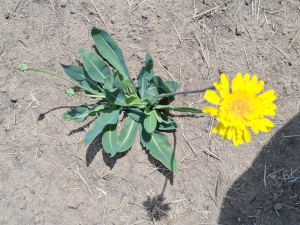
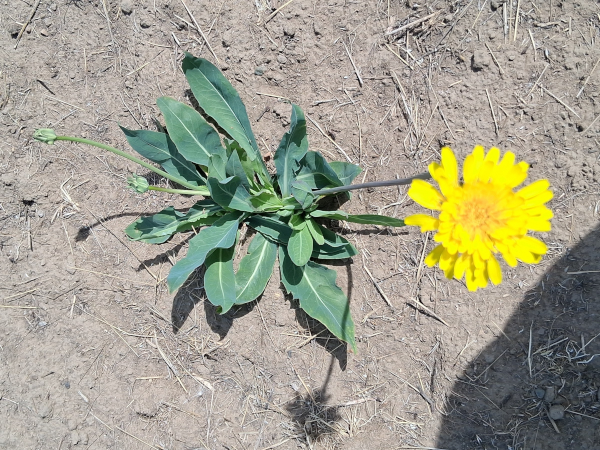
Prairie agoseris / Moisture Indicator
|
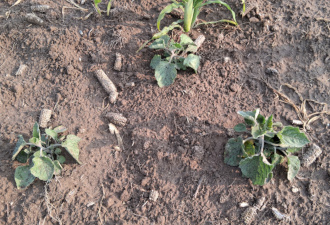
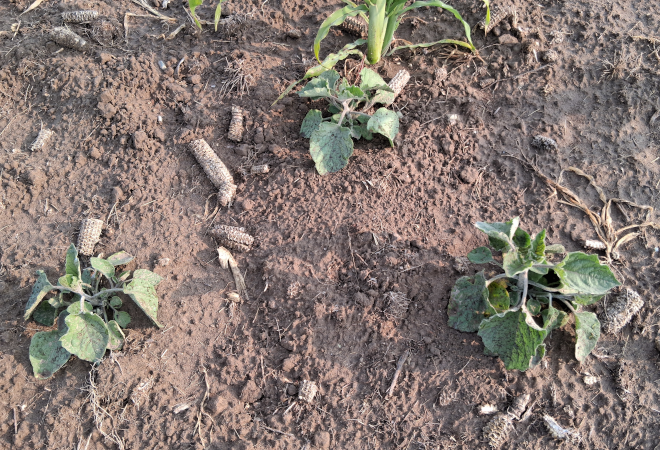
Physalis peruviana Volunteer / 2025
|
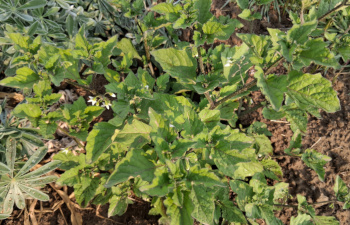
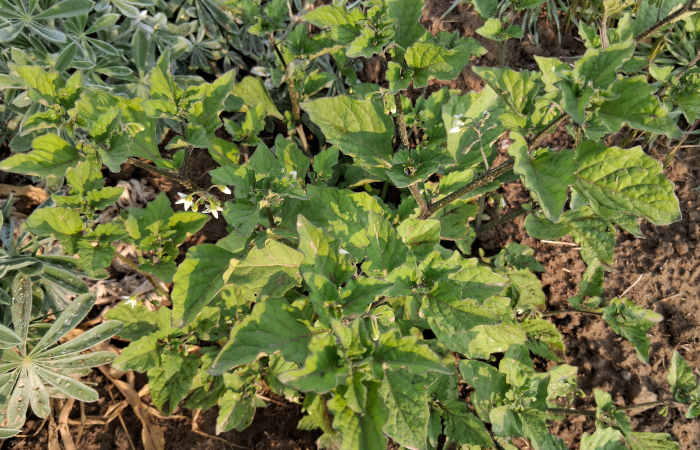
Wonderberry Volunteer / 2025
|
Part of the Mid-West field originally had a patch Prarie agoseris and both the corn and weeds are growing better than average in this area. This area was were we planted Hopi Turquoise in 2023 and is between the 2024 Concha White and Smoik Hu:n fields. Before clearing the south part of the 2024 Smoik Hu:n field had thicker than average grass cover, and the corn and weeds are doing better than average in that area. We removed some closely packed volunteer corn growing in this area. We hand pulled the worst of the weeds in Field 2, but (due to size of the prickly lettuce) we switched to a grub hoe.


Field 2 / Dryland Hopi Corn 2025
|
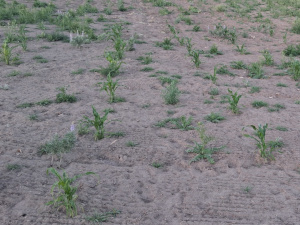
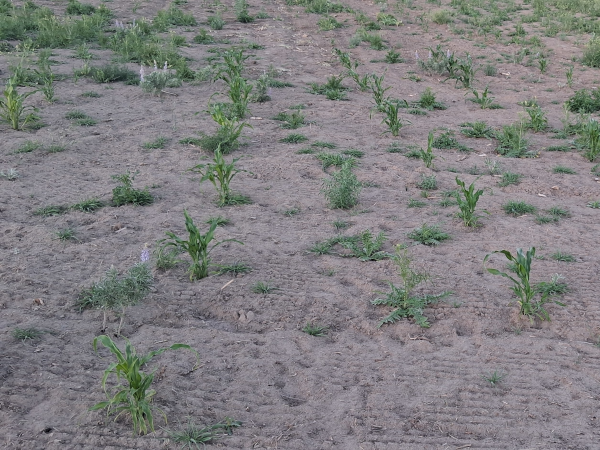
Field 2 / Jun 09 2025 / Before The Weeds Got Big
|

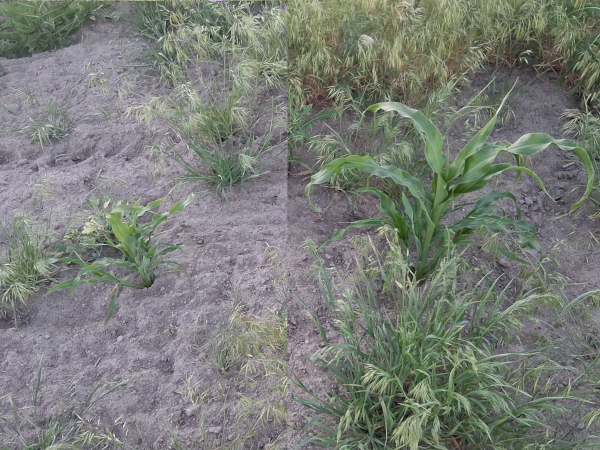
Adjacent Plants - Unfilled Hole Left / Filled Right
|
Hopi Corn Experiment / Practicing Golf With a Grub Hoe and Prickly Lettuce - Update June 23 2025
Part of Field 2 has been partially weeded, first by hand, then with a grub hoe. The area with good emergence formed a horse shoe shape around the patch planted with "yellow" kernels which didn't germinate. This area was later replanted with Yellow Glow, sorghum, and a few hills of squash. The pictures below are after a very short evening thundershower.
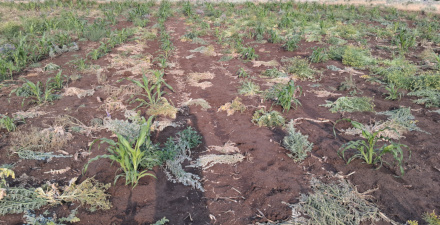
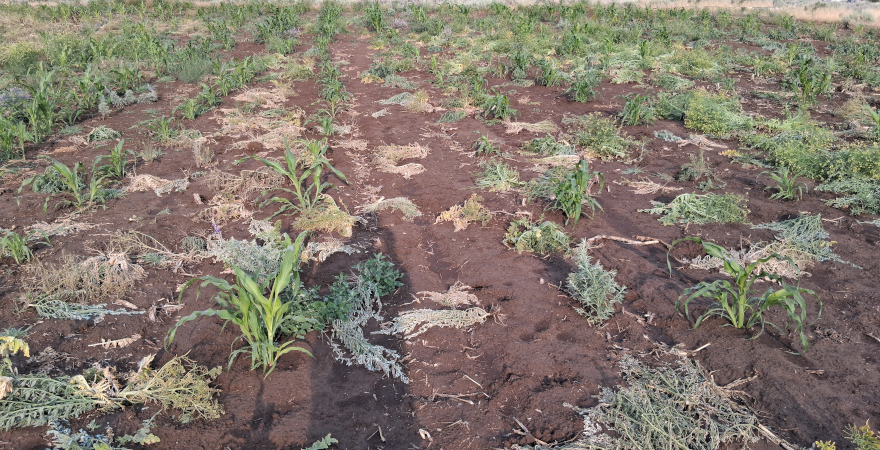
Field 2 / Weeding / June 23 2025
|
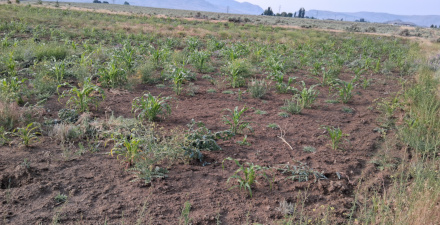
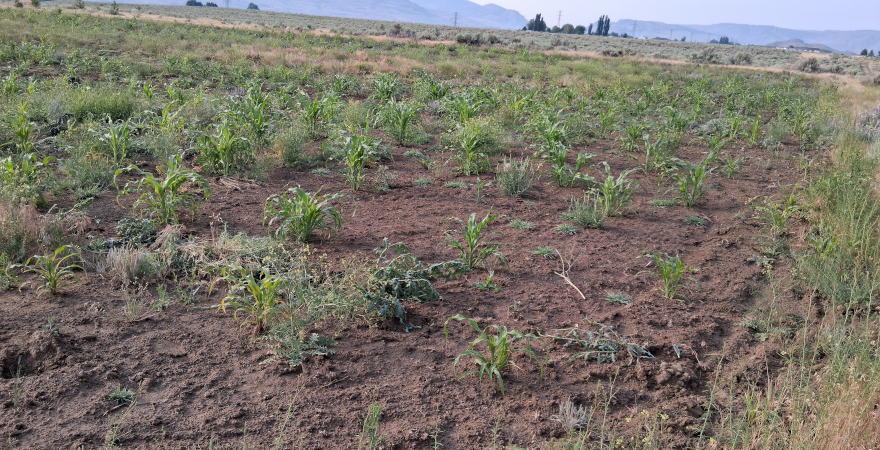
Field 2 / Weeding / June 23 2025
|
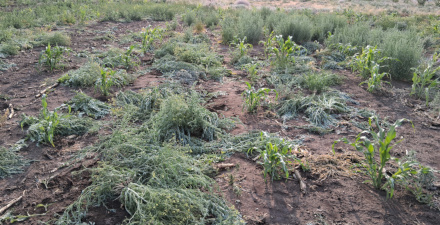
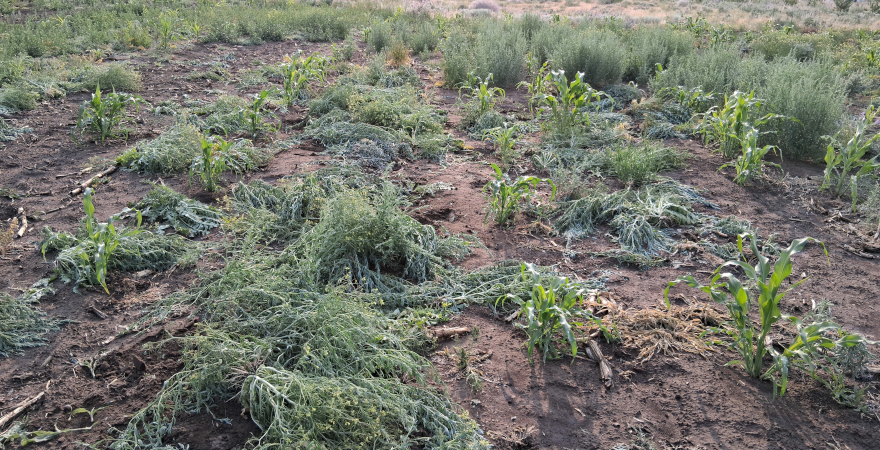
Field 2 / Weeding / June 23 2025
|
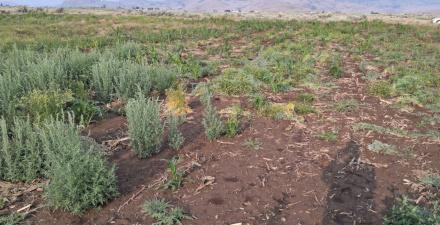
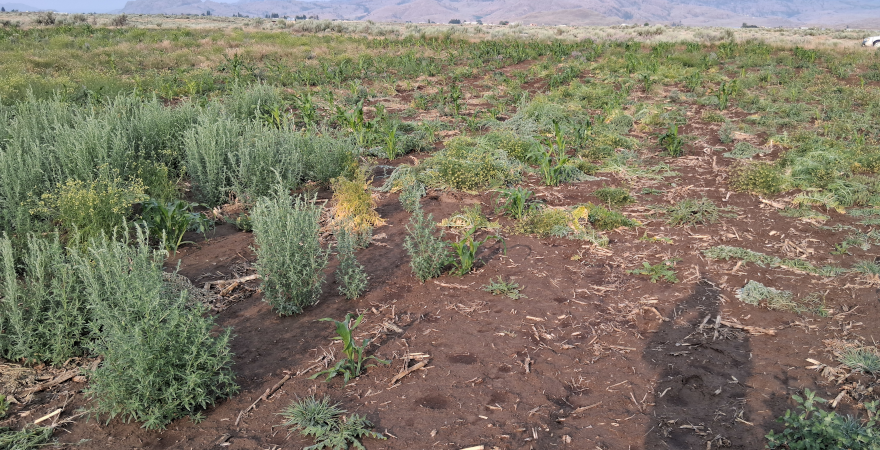
Field 2 / Partly Weeded Aridland Goosefoot / June 23 2025
|
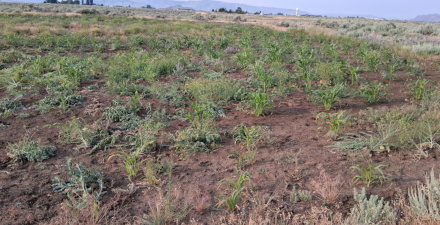

Field 2 / Weeding / June 23 2025
|
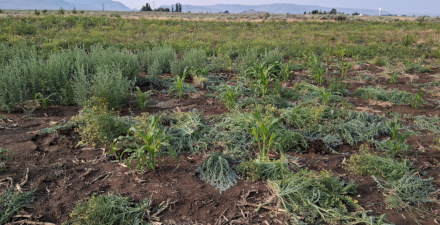
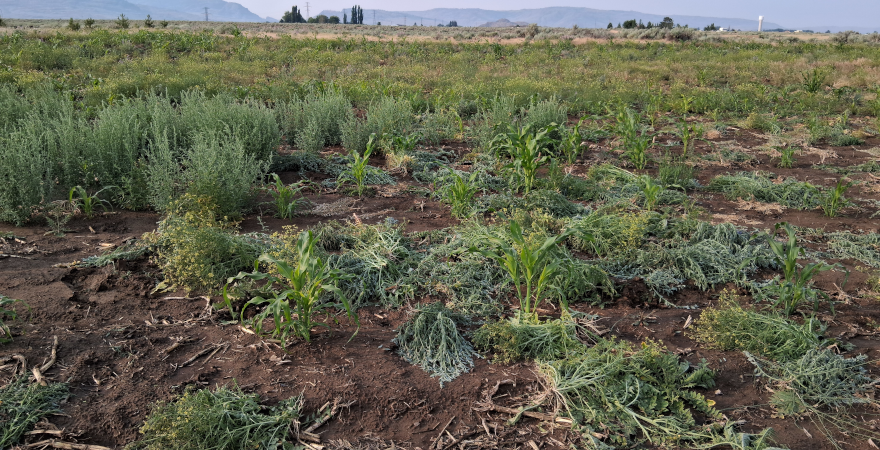
Field 2 / Partly Weeded Aridland Goosefoot / June 23 2025
|
Update June 30 2025
The Hopi Grey Squash is doing very well, and we planted a row of drip irrigated tepary anasazi beans. In previous years we didn't have much of a weed problem, and it is likely that using a cultipacker after tilling stimulated weed seed germination. After weeding operations Field 2 is looking better and we tried some weeding in the other fields with a grub hoe and a weed whacker. Corn is most susceptible to weeds when the weeds are from 4-6 inches high and until the V6 when the corn has 6 or more leaves. Delayed weed control can reduce corn yield by as much as 3 bushels per acre per day! The cheatgrass, lambsquarters, and other weeds compete with corn for light, nutrients, and water. In areas heavily infested with weeds the corn is yellow and spindly, and we have lost a large portion of our harvest to weeds, mostly cheatgrass, lambsquarters, prickly lettuce, and lemon balm. The grub hoe seems to work better in close quarters and usually removes the roots while the weed whacker can easily damage the corn and doesn't remove the roots.
List of Weeds - Ordered Worst to Least for 2025
- Cheat Grass, Grasses spp. (aggressive seeder, very competitive)
- Lambs Quarters (aggressive seeder, very competitive, deep rooted difficult to remove)
- Rush skeletonweed (seems to compete heavily for water)
- Lemon Balm (aggressive seeder, very competitive in certain areas)
- Prickly Lettuce (aggressive seeder, prickly with sticky sap)
- Aridland Goosefoot (aggressive seeder, not as competitive, not as deeply rooted)
--- below are less troublesome for this year --- - Witchgrass (aggressive seeder)
- Tar Weed (aggressive seeder, prickly)
- Tumble Weed (aggressive seeder, prickly)
- Red Root Pigweed (aggressive seeder)
- Scotch Thistle (aggressive seeder, prickly)
- Tumble Mustard (aggressive seeder)
- Mustard (aggressive seeder)
- Diffuse Knapweed (aggressive seeder. prickly)
- Dalmation toadflax
- Dandelion (aggressive seeder, deep tap root but relatively easy to remove)
The best solution for weed control without herbicides will be to arrange row spacing and till between the rows early in the season before the surface of the soil dries and while conditions are favorable for weed germination. After tilling, the remaining weeds can be removed with a grub hoe and/or pulled by hand. Once weeds are big, both a grub hoe and weed trimmer (with blade not trimmer line) are not effective, and the trimmer easily damages corn stalks when corn is closely spaced or close to weeds. When corn is planted 3' x 3' it is better to pull weeds by hand (or better don't plant 3' x 3').
In 2025 we used the cultipacker to firm the soil and decrease moisture loss but this also increased weed seed soil contact and weed germination rates. Retrospective overservation is that fields that were trenched then filled with the rebar harrow in 2023 and 2024 seemed to have fewer weeds than fields that were tilled then packed with the cultipacker. To realize the benefits of using a cultipacker, improved weed management is necessary.
Update July 07 2025
Since time is limited, areas that have the best looking corn get weeded first. The grasshoppers are bad this year but hopefully distracted by the weeds. There is one stalk of corn in the Hopi Pink field that is 2 feet taller and has 4 ears, taller and earlier than any other corn to date. This plant is from seeds selected in 2024 as Hopi Pink - Super 4, and we'll save these seeds as "Hopi Pink - Super 4 Early".
In previous years we found planting distance can be very important. This year we planted farther apart and in some areas the corn is not doing well despite not being crowded. Areas with the best weed growth also have the best corn growth, and in other the corn is doing poorly despite having few or no weeds. This indicates that planting distance and weeds are not the only factors affecting yield. Consistently, corn planted in the lowest areas (usually the center of the field) do poorly with corn around the (center) low area doing better. In one area Rush skeletonweed did well in the poor area where no corn grew. The lowest area of the south field is at the south edge and corn also does poorly in this area. South facing slopes accumulate more snow in winter and consistently do slightly better than north facing slopes. In addition to all other factors location is very important and planting areas must accumulate and retain enough moisture to grow corn successfully.
This is reminicent of the process of getting well water to fruit trees. The well has to have water and the power, the pump, the main line, the timer, all the way down the the drippers have to be working for the trees to get water. If any part of the system isn't working, the trees won't get water. It is the same for growing corn, all conditions have to be met to get an acceptable yield (conversely, one thing not in order = reduced corn yield).
Some areas may not be suitable for growing corn, and for larger dry areas it may be better to plant alfalfa or winter wheat. We'll continue to plant the same areas next year since continued fertilization and cultivation may increase soil organic matter and water holding capacity.
The corn seems to be drying out sooner than in 2024 so we did some comparisons. It seemed we had an earlier spring and snow melted in March rather than April but comparison of average monthly temperatures doesn't support this observation. That being said if the snow melted earlier there would be less moisture available on the surface layers in June and July. Records show that we had 2.28 inches or 39% less precipitation this year between January 01 and June 30 as compared to 2024. This is the lowest 6 month Jan-June precipitation sum since 2002 with a 2000-2025 average of 6.05 inches.
| Precipitation Comparison | ||
|---|---|---|
| Month | Precip. 2024 | Precip. 2025 |
| January | 2.19 | 0.50 |
| February | 0.55 | 0.78 |
| March | 1.44 | 1.45 |
| April | 0.43 | 0.34 |
| May | 0.56 | 0.45 |
| June | 0.67 | 0.04 |
| YTD Total | 5.84 | 3.56 |
Summary of Improvements
- Do not throw reject corn into the field, "as fertilizer", without composting.
- Till deeply and slowly to remove all weeds and get fine well prepared seed bed of loose soil.
- Cultipack to firm the soil and reduce wind erosion of soil and evaporative loss of soil moisture. Run the cultipacker separately after tilling at a brisk speed (with the tiller raised) to prevent soil piling up in front of the cultipacker.
- Mark the rows by driving a tractor at intervals far enough apart so the tiller can pass between the rows to control weeds. Mark the other directions perpendicular to the first in a square pattern. Our tractor is 4.5 feet wide with the tiller 5 feet wide. Driving 2 feet from the adjacent tire mark will result in rows 6.5 feet wide with 3/4 foot extra on each side of tiller.
- Mark the augur for depth and drill holes 6 inches deep. If there is sufficient moisture at 6 inches, 6 inches is deep enough. In 2025 many holes were drilled to 10 inches with the expectation that there would be some cave-in before seed deposit, but many did not cave in and 10 inches deeper than ideal. Experimental reports say that Hopi corn can emerge when planted as deep as 18 inches inches, but from our tests the seedlings that do emerge from more than 8 inches will be weaker.
- Make sure the planter follows directly behind the driller so all holes are planted.
- If not planning to thin, plant in hills 6 - 6.5 feet apart with 3 - 6 seeds per hole, assuming that in a fair number of the hills at least one kernel will not emerge. Some hills with 3 or 6 seeds is acceptable. If planning to thin use 7 - 10 seeds per hole and thin to 3 - 5 plants per hill.
- Tease loose soil in to fill the augur drilled holes from the bottom up.
- To control weeds, plant in rows wide enough to till between rows, and till 1-3 inches deep between rows early in the season when weeds are 3-4 inches high and before the surface of the soil is dry (dusty).